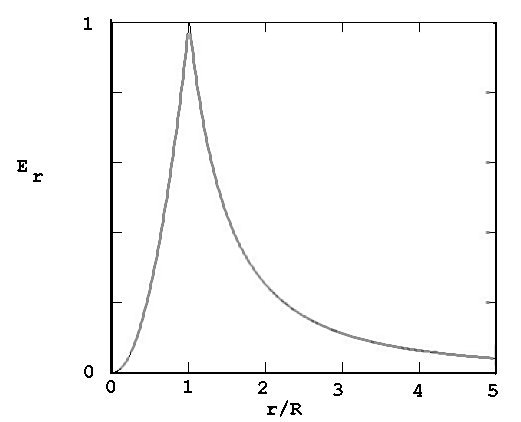
(a) Proof.
(b) The two fields are equal.
(c) The fields point in opposite directions, away from the respective
charges.
(d) Discussion.
Problem #13.
| x | ( E - Eexact )/ Eexact |
|---|---|
| R/300 = 0.003 R | -0.003 |
| R/150 = 0.007 R | -0.007 |
| R/10 = 0.10 R | -0.100 |
(b) The neglected term is 1% of the exact result when x = 0.01 R
Problem #14.
(a). lambda= q / L
(b) E1(a) = [ lambda / (4 pi epsilon0) ] L / [ a (a+L) ]
(c) F = k (lambda)2 ln { [(L+d)2 ] / [d (2L+d) ] }
(d) Proof.
Problem #15.
(a) -q on the inside
(b) +q on the outside
(c) and (e) E = [ 1 / ( 4 pi epsilon0 ] [ q / r2 ] 1r for r < a and r > b
(d) E = 0 for a < r < b
(f) E = + [ 1 / ( 4 pi epsilon0 ] [ q / r2 ]
1r is the field due to the central point charge and
E = - [ 1 / ( 4 pi epsilon0 ] [ q / r2 ]
1r is the field due to the charge on the inner surface.
The two fields cancel, leaving a net field (from these two only) of zero.
(g) The field due to the central point charge is
E = + [ 1 / ( 4 pi epsilon0 ] [ q / r2 ]
1r
The total electric field for r>b is the same.
(h) yes
(i) no
(j) yes
(k) no
(l) no, but you have to be very careful about what force is exerted by what charge.
Problem #16.
Proof
Note also that outside the sphere the electric field is that of a point charge, so that a plot of the (radial) electric field looks like
Problem #17.
E = 0 for r < a
rho (r2 - a2)
E= ---------- -------- 1r for a<=r<=b
2 epsilon0 r
rho (b2 - a2)
E = ---------- ------- 1r for r > b
2 epsilon0 r
Note that at each boundary the inside field at the boundary is equal to the outside field at the boundary. This equality must be true for the answer to be correct.
Problem #18.
E = B / epsilon0 for r <= R
E = B R / ( epsilon0 r ) for r >= R
| Last revised 1998/03/01 |